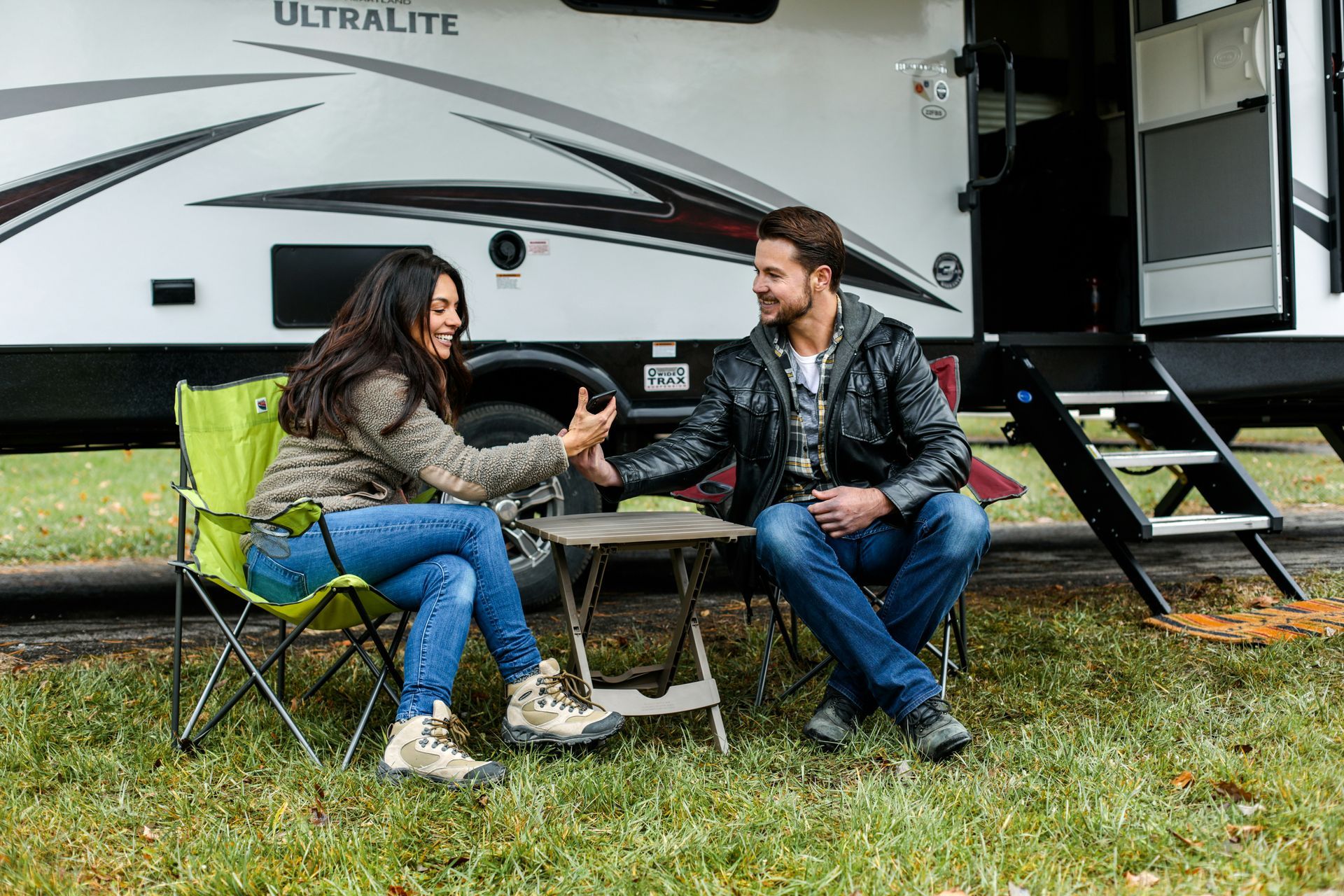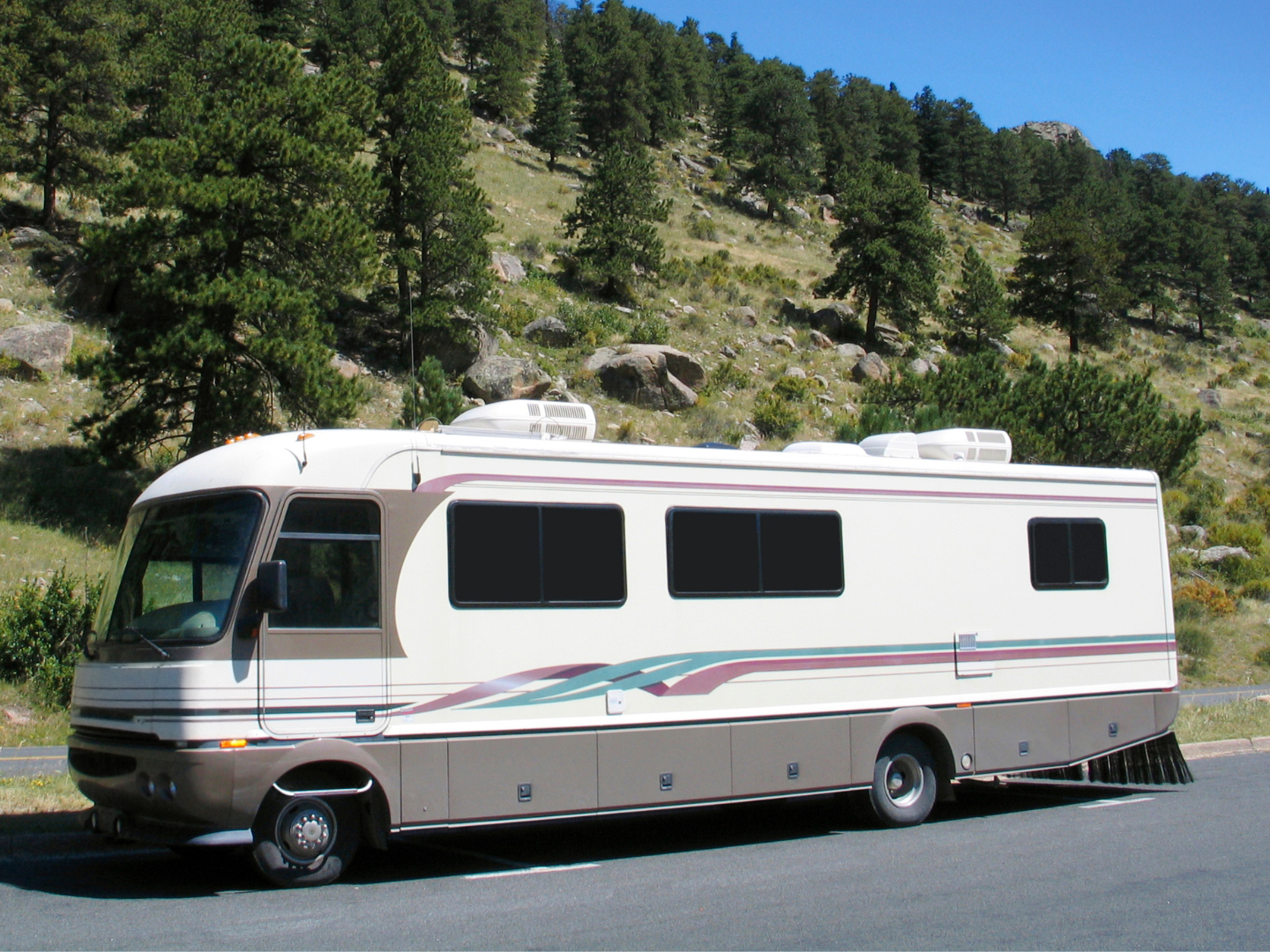Blog Layout
Preparing Your RV for Long-Term Storage: A Comprehensive Checklist
August 23, 2024
When the adventure season ends, and it's time to store your RV for an extended period, proper preparation is essential. Ensuring your RV is ready for long-term storage will not only keep it in great condition but also save you time and money when it's time to hit the road again. Here’s a comprehensive checklist to guide you through the process.
1. Clean and Inspect the Exterior
Wash and Wax: Start by thoroughly washing your RV to remove dirt, grime, and bugs. A good coat of wax will protect the exterior from the elements.
Check Seals and Roof: Inspect all seals, seams, and the roof for cracks or damage. Repair any issues to prevent leaks during storage.
2. Protect the Tires
Inflate Tires: Inflate your tires to the manufacturer-recommended pressure. Under-inflated tires can develop flat spots during storage.
Use Tire Covers: Protect your tires from UV damage by using tire covers. If possible, move the RV occasionally to prevent flat spots.
3. Drain and Winterize the Plumbing System
Drain Water Tanks: Empty all freshwater, greywater, and blackwater tanks. Clean them thoroughly to avoid any residue buildup.
Add Antifreeze: If you're storing your RV in a cold climate, add RV-specific antifreeze to the plumbing system to prevent freezing and damage.
4. Take Care of the Battery
Disconnect the Battery: Disconnect the battery to prevent it from draining. Store it in a cool, dry place, and check the charge periodically.
Use a Trickle Charger: Consider using a trickle charger to maintain the battery charge over the storage period.
5. Secure the Interior
Clean the Interior: Remove any food items and clean the interior thoroughly to avoid attracting pests.
Leave Cabinet Doors Open: This allows air circulation and prevents musty odors from building up inside your RV.
Close Windows and Vents: Ensure all windows, vents, and skylights are closed and sealed to keep out moisture and pests.
6. Protect Against Pests
Seal Entry Points: Check for any gaps or openings where pests could enter and seal them.
Use Pest Repellents: Place pest repellents, like mothballs or natural alternatives, throughout the RV, particularly in areas where pests might hide.
7. Cover and Ventilate
Use an RV Cover: Invest in a quality RV cover that fits your vehicle. A good cover will protect against sun, rain, and debris.
Ventilation: Use roof vents or small openings to allow air circulation and prevent mold and mildew buildup.
8. Consider the Location
Choose a Secure Storage Facility in LaSalle, CO: Select a storage facility like Big Bend Boat and RV Storage, where your RV is safe from theft, vandalism, and weather damage.
Indoor vs. Outdoor Storage: If possible, opt for covered or indoor storage to provide extra protection.
9. Prepare the Engine and Fuel System
Top Off Fuel: Fill the fuel tank to prevent moisture from accumulating inside. Add a fuel stabilizer to keep the fuel fresh.
Change Oil and Filters: Perform an oil change and replace the filters to keep your engine in good condition during storage.
10. Check Insurance and Registration
Review Your Coverage: Ensure your insurance policy covers storage periods. Some policies may require adjustments for long-term storage.
Keep Registration Updated: Make sure your RV registration is up-to-date, even while in storage.
Properly preparing your RV for long-term storage is crucial to maintaining its value and functionality. By following this comprehensive checklist, you'll ensure your RV remains in top condition, ready for your next adventure.
At Big Bend Boat and RV Storage, we offer secure and convenient storage options to keep your RV safe year-round. Contact us today to learn more about our facilities and how we can help protect your investment.

December 17, 2024
Retirement is an exciting milestone, offering the chance to slow down, explore hobbies, and spend quality time with loved ones. For many empty nesters, it’s also the perfect time to downsize and transition to a smaller home. While this move brings plenty of benefits—like less maintenance and lower costs—it can also be an emotional and logistical challenge, especially if you own RVs, boats, or extra vehicles. That’s where RV, boat, and vehicle storage at Big Bend Boat and RV Storage near LaSalle, CO, comes in. Our secure facility simplifies the downsizing process, offering a safe place to store large vehicles and recreational toys you’re not ready to part with. Here are some practical tips for making the transition to a smaller space while keeping your RV, boat, and belongings organized and protected. 1. Start with a Plan Downsizing is about more than just moving to a smaller home—it’s an opportunity to rethink your priorities and lifestyle. Start by evaluating your new space and listing the essentials you need to bring, such as furniture, clothing, and everyday items. For larger belongings like boats, RVs, and extra vehicles, consider renting a secure storage space. Big Bend Boat and RV Storage provides ample room to safely store your recreational vehicles while freeing up valuable space at home. 2. Declutter and Prioritize Space Decluttering an entire home can feel overwhelming, but breaking it down into smaller tasks makes it manageable. As you sort through items, create categories: Keep: Essentials you use regularly or that hold deep sentimental value. Donate/Sell: Items in good condition that no longer serve you. Store: Boats, RVs, vehicles, and recreational gear you’re not ready to part with. Instead of crowding your new space, rely on vehicle storage near LaSalle to keep your RV or boat secure while still having easy access for weekend adventures or road trips. 3. Safeguard Your RV, Boat, and Specialty Vehicles While downsizing may mean letting go of certain things, it doesn’t mean giving up your passions. Whether you own an RV for travel, a boat for weekends on the lake, or classic cars, these investments deserve proper care and storage. At Big Bend Boat and RV Storage, our spacious, secure facility ensures your recreational vehicles are protected year-round. With features like gated access and ample parking, you can rest easy knowing your valuable toys are safe and ready for your next adventure. 4. Make Room for New Adventures Downsizing your home doesn’t mean downsizing your lifestyle. Many retirees look forward to cross-country RV trips, weekends on the water, or restoring classic cars. Having a reliable, secure storage space ensures you can fully embrace these hobbies without worrying about where to park your vehicles or boats. With Big Bend Boat and RV Storage near LaSalle, CO, you’ll have convenient access to your RV, boat, or car anytime you’re ready to hit the road or the water. 5. Use Storage as a Transition Zone Deciding what to keep or let go of takes time. Use storage as a transition zone for your RV, boat, or other items while you settle into your new space. If you’re unsure whether you’ll use certain vehicles or gear, storage provides flexibility until you’re ready to make a decision. After a few months, revisit your storage space to determine what you truly need. With your RV or boat stored nearby, you can still enjoy spontaneous trips while keeping your home clutter-free. 6. Stay Organized with Smart Storage Solutions To make the most of your storage space, stay organized with clearly labeled bins for tools, gear, and smaller items that pair with your RV, boat, or vehicles. Group items by category—like camping supplies, fishing equipment, or cleaning tools—so you always know where everything is. Having a designated storage space ensures your vehicles and gear remain organized, accessible, and ready for your next outing. 7. Choose the Right Storage Facility When selecting a storage facility, consider size, security, and accessibility. Big Bend Boat and RV Storage near LaSalle offers a range of secure, spacious storage options tailored to RVs, boats, and vehicles. Our facility features gated access, ample parking, and easy maneuvering for large vehicles, giving you peace of mind and convenience. Why RV, Boat, and Vehicle Storage Is a Game-Changer for Downsizing Downsizing doesn’t mean you have to sacrifice the things you love—like your RV, boat, or classic cars. With the help of secure storage at Big Bend Boat and RV Storage, you can transition to a smaller home while keeping your vehicles safe, organized, and ready for new adventures. Take the Stress Out of Downsizing Retirement is the perfect time to focus on what matters most, from traveling in your RV to spending days on the water. By using a dedicated storage facility, you can simplify your life, protect your investments, and enjoy the freedom of a clutter-free home. Ready to get started? Contact Big Bend Boat and RV Storage today to reserve your RV, boat, or vehicle storage space near LaSalle, CO, and make your downsizing journey stress-free!

November 20, 2024
Owning a boat or RV unlocks countless adventures, but proper storage is essential when you’re not out exploring. Dedicated boat and RV storage facilities , like Big Bend Boat and RV Storage near Greeley, CO, offer tailored solutions to meet your needs. Here are the top five benefits of choosing a specialized storage facility for your boat or RV. 1. Protection from the Elements Boats and RVs are valuable investments, and prolonged exposure to weather can cause significant wear and tear. Dedicated storage facilities often provide covered spaces to shield your vehicle from harmful UV rays, snow, and rain, helping to preserve its condition. At Big Bend Boat and RV Storage, our covered parking options are designed to keep your vehicle in great shape, extending its lifespan and reducing maintenance costs. 2. Enhanced Security Leaving your boat or RV in an open driveway or on the street can be risky. Specialized storage facilities are equipped with security features such as gated access, surveillance cameras, and well-lit areas, giving you peace of mind. Big Bend Boat and RV Storage prioritizes your vehicle’s safety with these advanced measures, so you can rest easy knowing your investment is protected. 3. Freeing Up Space at Home Boats and RVs can take up a lot of room in your driveway, yard, or garage, making it challenging to manage your space effectively. Storing them at a dedicated facility frees up valuable space at home, making life more convenient. Whether you need extra room for other vehicles, yard activities, or simply want to improve your curb appeal, Big Bend’s spacious facility is the perfect solution. 4. Convenient Access to Your Adventures Convenience is key when you’re ready to head out on your next adventure. Dedicated storage facilities like Big Bend Boat and RV Storage are strategically located near popular outdoor destinations, ensuring quick and easy access to your vehicle. Our extended access hours mean you can pick up your boat or RV whenever you’re ready, making those last-minute getaways or planned trips stress-free. 5. Keeping Your Vehicle in Top Shape Proper storage helps protect your boat or RV from accidental damage or environmental wear. By storing your vehicle in a facility designed for larger vehicles, you ensure that it has adequate space and ventilation. Big Bend’s setup minimizes risks like damage from crowded driveways or exposure to road debris, helping your boat or RV stay in excellent condition for the long haul. Understanding the Cost of RV Storage and Choosing the Right Solution Storing an RV is a critical part of ownership, as it ensures your vehicle remains in great condition and ready for your next adventure. The cost of RV storage can vary widely based on factors like the type of storage, location, and additional amenities. At Big Bend Boat and RV Storage near Greeley, CO, you’ll find competitive rates that reflect the premium security and convenience offered by the facility. Types of RV Storage Outdoor Storage: The most affordable option, providing open parking spaces for your RV. While cost-effective, it exposes your vehicle to the elements. Covered Storage: A mid-range option that shields your RV from sun, rain, and snow, helping to preserve its exterior and reduce maintenance costs. Enclosed Storage: The premium choice, offering fully enclosed units for maximum protection against weather and security risks. Why Store Your Camper at a Dedicated Facility? Storing your RV at a professional facility like Big Bend ensures your vehicle is safe, accessible, and well-maintained. With features like wide driveways, covered parking, and state-of-the-art security, Big Bend Boat and RV Storage provides the ideal environment for your RV or camper. Plus, its convenient location near Greeley, CO, means you’re never far from your next road trip or camping getaway. Why Choose Big Bend Boat and RV Storage? At Big Bend Boat and RV Storage, we understand the unique needs of boat and RV owners. Our facility combines security, protection, and convenience to make storing your vehicle stress-free. With covered storage options, advanced security measures, and a prime location near Greeley, CO, we are the trusted choice for your storage needs. Ready to reserve your spot? Contact us today to learn more about our storage solutions and secure the perfect space for your boat or RV . Your next adventure starts here!

October 28, 2024
LaSalle, Colorado, is perfectly situated for RV and boating enthusiasts looking to explore beautiful outdoor destinations. With stunning reservoirs, scenic campgrounds, and exciting watersports, the area offers a range of options for those ready to hit the road or set sail. Whether you’re a local or storing your RV or boat at Big Bend Boat and RV Storage, here are some top spots nearby to consider for your next adventure. 1. Horsetooth Reservoir Distance from LaSalle: ~30 miles Highlights: Boating, camping, fishing, and hiking Just a short drive from LaSalle, Horsetooth Reservoir is one of Colorado’s premier spots for boating and water sports. With stunning views and plenty of open water, it’s ideal for jet skiing, kayaking, paddle boarding, and motor boating. The reservoir also has numerous camping spots perfect for RVs, giving you the opportunity to wake up next to the water. 2. Boyd Lake State Park Distance from LaSalle: ~20 miles Highlights: Full-service marina, sandy beach, fishing, and picnicking Boyd Lake offers a full-service marina and great amenities for boaters and RV enthusiasts alike. Its beautiful sandy beach is perfect for families, and the lake’s warm waters make it an excellent spot for summer outings. The park also has 148 pull-through campsites with electrical hookups, making it easy to set up your RV and relax. 3. Carter Lake Reservoir Distance from LaSalle: ~40 miles Highlights: Boating, scuba diving, sailing, and fishing Carter Lake is a lesser-known gem for boaters and RV travelers looking for a more tranquil setting. The lake is ideal for sailing and fishing, and it’s even popular with scuba divers exploring the underwater terrain. Carter Lake’s campsites offer incredible views and the perfect base for exploring the natural surroundings. 4. Jackson Lake State Park Distance from LaSalle: ~50 miles Highlights: Watersports, camping, wildlife viewing, and sandy beach Known as an "Oasis on the Plains," Jackson Lake State Park is a fantastic destination for watersports enthusiasts. The park offers ample space for boating, jet skiing, and paddle boarding. RV-friendly campsites near the lake make it a perfect weekend retreat, while the nearby trails are excellent for hiking and spotting local wildlife. 5. Lake Granby Distance from LaSalle: ~85 miles Highlights: Boating, fishing, hiking, and stunning mountain scenery Lake Granby, part of the Colorado River, is one of the state’s largest lakes and offers breathtaking mountain views. It’s a bit farther from LaSalle but well worth the drive, with ample opportunities for fishing, boating, and exploring nearby hiking trails. It’s also near the town of Granby, which offers a cozy mountain town experience with local dining and attractions. 6. Red Feather Lakes Distance from LaSalle: ~60 miles Highlights: Quiet fishing spots, canoeing, kayaking, and RV camping For a more serene getaway, Red Feather Lakes offers smaller, tranquil lakes perfect for canoeing and fishing. The area also has RV camping spots nestled in the beautiful scenery of the Roosevelt National Forest. This destination is ideal if you’re looking for a peaceful retreat close to nature, with a variety of smaller lakes to explore. 7. Eleven Mile State Park Distance from LaSalle: ~130 miles Highlights: Premier fishing destination, boating, and stunning views While a bit farther away, Eleven Mile State Park is a premier fishing and boating spot in Colorado. Known for its clear waters and abundant fish species, the lake offers the perfect setting for fishing from a boat or the shore. The park also has numerous campsites that cater to RVs, making it an excellent extended weekend destination. Plan Your Next Adventure from Big Bend Boat and RV Storage! These top destinations near LaSalle, CO, provide endless possibilities for boating and RV trips. With secure and convenient storage at Big Bend Boat and RV Storage, your vehicle and watercraft are always ready for the next adventure. Store your boat or RV with confidence, and enjoy the freedom to explore Colorado’s incredible landscapes and waterways anytime!

September 10, 2024
Storing your RV properly is essential to ensuring it remains in great condition, ready for your next adventure. One common question many RV owners have is: What should I keep inside my RV during storage, and what should I take out? Knowing the answer can help protect your belongings and extend the lifespan of your RV. Here’s a guide to help you determine what stays and what goes when storing your RV. What to Keep Inside Your RV During Storage 1. Bedding and Linens (if cleaned and stored properly) It’s fine to leave bedding, pillows, and blankets in your RV as long as they are clean and stored in sealed containers. This prevents dust buildup and reduces the chance of pests making a home in your linens. 2. Kitchenware Utensils, pots, pans, and other non-perishable kitchenware can remain in your RV. However, it’s important to ensure they are clean and dry to prevent mold or bacteria growth. 3. Basic Maintenance Tools You never know when you’ll need tools for minor repairs or maintenance. Keep a small toolbox with basic tools such as wrenches, screwdrivers, and tape. Just make sure the tools are stored securely to avoid damage during storage. 4. RV-Specific Items Items that you’ll need once you’re back on the road, such as water hoses, electrical cords, and leveling blocks, can remain in the RV. Storing them inside the RV keeps everything organized for your next trip. 5. Durable Outdoor Gear Sturdy items like camping chairs, folding tables, or grills can be stored inside your RV if space allows. Make sure to clean and dry them thoroughly to prevent rust and mold. What to Leave Out of Your RV During Storage 1. Perishable Food Items This is one of the most critical items to remove. Any food left in your RV, no matter how well sealed, can attract pests or mold. Make sure all food, including dry goods, is removed from the pantry, refrigerator, and cabinets. 2. Personal Electronics Laptops, cameras, and other personal electronics should be taken out. Temperature fluctuations in storage can damage sensitive electronic components, and if left for long periods, batteries may corrode. 3. Valuables Items like jewelry, important documents, or anything with sentimental or monetary value should always be removed from your RV. While many storage facilities offer great security, it’s always better to err on the side of caution. 4. Cleaning Supplies and Chemicals Household cleaners, propane tanks, and other flammable materials should be removed from your RV. Fluctuations in temperature can cause these items to leak or create safety hazards. 5. Batteries Remove any small batteries from devices inside your RV. Leaving them in for extended periods can lead to corrosion, damaging your devices. For your RV’s main battery, disconnecting or removing it can prevent draining during storage. Final Tips for RV Storage Clean Thoroughly: Before storing your RV, give it a thorough cleaning inside and out. Vacuum carpets, wipe down surfaces, and ensure there’s no leftover food or crumbs. Pest Prevention: Seal up any openings, use moisture absorbers, and consider placing pest deterrents like mothballs or traps to avoid unwanted guests in your RV. Cover and Protect: Use an RV cover or tarp to shield your RV from sun, rain, and debris during storage. By following these guidelines and knowing what to keep inside your RV versus what to take out, you’ll ensure your vehicle is safe, well-maintained, and ready for the road when the time comes. At Big Bend Boat & RV Storage, we provide secure and convenient storage solutions so you can have peace of mind knowing your RV is in great hands. If you’re ready to store your RV or have any questions, contact us today!

July 18, 2024
It’s essential to properly prepare your boat for long-term storage. At Big Bend Boat and RV Storage in LaSalle, CO, we understand that your boat is a valuable investment, and taking the right steps to store it can ensure it remains in top condition for years to come. Here’s a comprehensive guide to help you prepare your boat for long-term storage. 1. Clean Your Boat Thoroughly Before storing your boat, give it a thorough cleaning inside and out. This includes: Washing the Exterior: Remove dirt, grime, and salt to prevent corrosion. Use a mild detergent and fresh water. Cleaning the Interior: Vacuum the carpets, wipe down surfaces, and remove any personal items. Inspecting for Damage: Check for any signs of damage or wear and address them before storage. 2. Drain and Dry Ensure all water is drained from the boat to prevent mold, mildew, and corrosion: Bilge: Drain any standing water from the bilge and clean it. Freshwater System: Drain the freshwater tank and water heater. Coolers and Live Wells: Empty and clean thoroughly. 3. Engine Maintenance Proper engine maintenance is crucial for long-term storage: Change the Oil: Old oil can contain contaminants that could harm the engine. Replace it with fresh oil and a new filter. Flush the Cooling System: Run fresh water through the cooling system to remove salt and debris. Fuel System: Add a fuel stabilizer to the gas tank and run the engine to circulate the stabilizer through the system. Fog the Engine: Spray fogging oil into the carburetor and spark plug holes to protect the engine’s internal components. 4. Protect Against Moisture Moisture is the enemy of long-term storage. Take steps to keep it at bay: Use a Dehumidifier: Place a dehumidifier or moisture absorbers in the cabin to prevent mold and mildew. Ventilation: Ensure there’s adequate ventilation to reduce moisture buildup. 5. Battery Care Properly maintain your boat’s battery during storage: Remove the Battery: Disconnect and remove the battery from the boat. Clean and Store: Clean the battery terminals and store the battery in a cool, dry place. Use a trickle charger to maintain the charge. 6. Cover Your Boat A high-quality cover can protect your boat from dust, dirt, and the elements: Choose the Right Cover: Use a cover that fits snugly and is designed for your boat type. Secure the Cover: Ensure the cover is securely fastened to prevent it from blowing off or allowing debris to enter. 7. Lubricate and Protect Lubrication can prevent rust and corrosion: Grease Moving Parts: Lubricate steering systems, hinges, and other moving parts. Spray Protectants: Apply anti-corrosion spray to metal surfaces and electrical connections. 8. Store Properly Finally, store your boat in a safe and secure location: Use a Storage Facility: Consider storing your boat at Big Bend Boat and RV Storage. Our facilities offer secure outdoor storage options to protect your investment. Elevate the Boat: If storing on a trailer, ensure the boat is properly supported and elevated to prevent flat spots on the tires and stress on the hull. Why Choose Big Bend Boat and RV Storage? At Big Bend Boat and RV Storage, we prioritize the safety and security of your boat. Our facilities in LaSalle, CO, are equipped with top-notch security features, and we offer a range of storage options to meet your needs. Whether you need short-term or long-term storage, we have you covered. Preparing your boat for long-term storage may take some time and effort, but it’s well worth it to protect your valuable investment. By following these steps, you can ensure your boat remains in excellent condition and is ready for the next boating season. Contact us today to learn more about our storage options and how we can help you keep your boat safe and secure.

June 19, 2024
Are you in search of the perfect place to store your boat or RV near Greeley, CO? Look no further than Big Bend Boat and RV Storage! Nestled in the scenic beauty of northern Colorado, Big Bend offers top-notch storage solutions designed to meet all your needs. Why Choose Big Bend Boat and RV Storage? At Big Bend, we understand the importance of keeping your recreational vehicles safe, secure, and ready for your next adventure. Here’s why Big Bend is the ideal choice for storing your boat or RV: Convenient Location Located just a short drive from Greeley, Big Bend Boat and RV Storage is easily accessible and conveniently situated for residents of the surrounding areas. Our prime location means you can quickly retrieve your vehicle and hit the road or water whenever the mood strikes. Spacious and Secure Storage We offer a variety of storage options to accommodate different sizes and types of boats and RVs. Our facility is equipped with ample space, ensuring your vehicle has enough room for easy maneuvering and parking. Plus, our state-of-the-art security measures, including 24-hour surveillance and gated access, provide peace of mind knowing your investment is well-protected. Affordable Rates At Big Bend, we believe in providing high-quality storage solutions at competitive prices. Our affordable rates make it easy for you to store your boat or RV without breaking the bank. We also offer flexible payment options and discounts for long-term storage. Exceptional Customer Service Our friendly and knowledgeable staff are always here to assist you. Whether you have questions about our storage options or need help with your vehicle, you can count on us for excellent customer service. We strive to create a positive and hassle-free experience for all our clients. Easy Access and Convenience With our extended access hours, you can visit your boat or RV at a time that suits you. We understand that your schedule may not always align with traditional business hours, so we offer the flexibility you need to access your vehicle when it’s most convenient. Enjoy the Great Outdoors with Big Bend Northern Colorado is a haven for outdoor enthusiasts, offering countless opportunities for boating, fishing, camping, and exploring the great outdoors. By choosing Big Bend Boat and RV Storage, you’re ensuring that your recreational vehicle is always ready for your next adventure. Whether you’re planning a weekend getaway or a longer journey, we’ve got you covered. Reserve Your Spot Today! Don’t wait until the last minute to secure storage for your boat or RV. Contact Big Bend Boat and RV Storage near Greeley, CO, today to rent your spot. Experience the difference that a dedicated, secure, and customer-focused storage facility can make. We look forward to serving you and helping you make the most of your recreational time!
© 2025
All Rights Reserved

